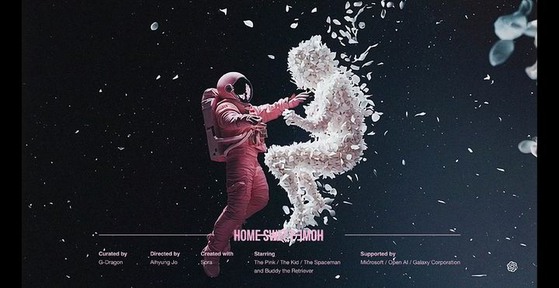![An image from singer G-Dragon's music video for ″Home Sweet Home″ (2024) [GALAXY CORPORATION]](https://koreajoongangdaily.joins.com/data/photo/2025/06/06/5c768510-5416-468c-91b0-511ec44a2f0e.jpg)
An image from singer G-Dragon’s music video for ″Home Sweet Home″ (2024) [GALAXY CORPORATION]
When Microsoft CEO Satya Nadella watched K-pop singer G-Dragon’s music video for “Home Sweet Home” (2024) for the first time, he openly expressed his shock — or so reports say.
The CEO saw the AI-generated music video during a client demo in Korea in March, during a presentation that showcased how local companies are using Microsoft’s AI.
In fact, the “Home Sweet Home” music video was created entirely using Sora, OpenAI’s video generation model available via Azure OpenAI Service.
“Producing a K-pop music video typically costs between $1 million and $2 million, but using Sora has cut expenses by more than 90 percent,” said Choi Yong-ho, CEO of G-Dragon’s agency Galaxy Corporation.
A new reality
AI video generation tools are being put to real-world use. They now realistically render characters without cameras or actors, syncing lip movements with speech and adding lifelike audio effects. The technology is no longer limited to exhibitions — it’s being adopted in actual content production.
“The creative process is going to change a lot in a couple of years, and that’s exciting,” said Demis Hassabis, CEO of Google DeepMind, in an interview with the Financial Times on May 30.
Industry insiders believe the unveiling of Veo 3, Google’s latest video generation model introduced at its annual I/O 2025 developer event, could mark a turning point. The tool can simultaneously generate dialogue, music, sound effects and lip-syncing, allowing creators to produce immediately usable videos without post-production.
![A video inserted with AI-created image after production [CJ ENM]](https://koreajoongangdaily.joins.com/data/photo/2025/06/06/62e670a5-e6a6-45ee-9a8d-6105d65b5d80.jpg)
A video inserted with AI-created image after production [CJ ENM]
“Veo can distinguish and replicate subtle differences in sound, like ice falling in the distance versus breaking nearby,” said Kang Jung-soo, director of the Bluedot AI Research Center. “It’s a qualitative leap from simple diffusion models that turn blurry images into clearer ones.”
In Korea, companies are also integrating AI video tools into production.
CJ ENM has applied AI-based virtual product placement in entertainment shows. A notable case was in the tvN program “Edward Lee’s Country Cook,” where AI inserted a product into scenes after filming, as if it had been physically present. Previously, adding such items post-shoot often required reshoots or was simply not feasible.
Last year, a short film titled “M Hotel,” created with AI, was named one of the top 10 finalists at the Venice International AI Film Festival.
“We have a dedicated AI team in-house and are continuously exploring how to blend technology with narrative,” a CJ ENM spokesperson said.
![Microsoft Chairman and CEO Satya Nadella speaks during a presentation of the company's AI assistant, Copilot, and 50th Anniversary celebration at Microsoft headquarters, in Redmond on April 4, 2025. [AP/YONHAP]](https://koreajoongangdaily.joins.com/data/photo/2025/06/06/68f94f5d-dcfc-492d-93fa-0a30b6b55659.jpg)
Microsoft Chairman and CEO Satya Nadella speaks during a presentation of the company’s AI assistant, Copilot, and 50th Anniversary celebration at Microsoft headquarters, in Redmond on April 4, 2025. [AP/YONHAP]
Why it matters
As video production becomes less expensive, the balance of power is shifting toward creators. Where execution used to depend on filming, now it’s about the speed and sharpness of ideas — with AI able to handle much of the heavy lifting.
“While AI advancement may pose a threat to some creators, it can also empower those who can develop their own stories,” said one industry source. “In the content world, AI presents both risks and opportunities.”
Writers who once relied solely on text can now visualize their concepts for investors. Webtoon creators can create film-style teasers of their work, and story-driven creators can now realize part of their vision on screen to open up new opportunities.
“The development of video AI goes beyond automation,” said a spokesperson for DeepBrain AI, a local AI video startup. “It signals a shift in content control from platforms to creators. We’re entering an era where individuals or small teams with creative ideas can produce and distribute their own content without technological barriers.”
Startups fill the gaps
Video AI combines previously separate advancements in language, image, voice and motion modeling into one service. Tech giants like Google, OpenAI and Meta — each with their own models — are entering the video AI race, while startups are gaining ground by offering more affordable services.
One example is Kling, a tool developed by the Chinese short-form platform Kuaishou. It supports video generation from five seconds up to two minutes and is optimized for short-form content. Meanwhile, U.S.-based startup Runway is expanding from AI video generation into full-scale content production.
Translated from the JoongAng Ilbo using generative AI and edited by Korea JoongAng Daily staff.
BY KWEN YU-JIN [[email protected]]

